Physical Address
304 North Cardinal St.
Dorchester Center, MA 02124
Diverticula are outpouchings from tubular structures. True diverticula involve all layers of the intestinal wall, whereas false diverticula are due to herniation of mucosa and submucosa through the muscular wall. Many diverticula contain attenuated portions of the muscular wall of the intestine, and hence may be difficult to define as true or false. True diverticula are often assumed to be congenital lesions, and false diverticula are assumed to be acquired, but this is not always the case. Some authors reserve the terms false diverticula or pseudodiverticula for diverticula caused by an inflammatory process. This chapter addresses diverticula of all parts of the GI tract, with the exception of Meckel diverticulum and colonic diverticula, which are covered in Chapters 98 and 121.
Ludlow first described a patient with a hypopharyngeal diverticulum in 1767, and in 1877 Zenker and Von Ziemssen reported 23 such patients.
The prevalence of Zenker diverticula has been estimated to be between 0.1% and 0.01%. Patients generally present in the seventh or eighth decade of life. Twice as many men as women develop Zenker diverticula.
Zenker diverticula are acquired. They develop when abnormally high pressures occur during swallowing, leading to mucosa that protrudes through an area of anatomic weakness in the pharynx known as Killian triangle (see Chapter 43 ). Killian triangle is located posteriorly where the transverse fibers of the cricopharyngeus muscle of the upper esophageal sphincter (UES) intersect with the oblique fibers of the inferior pharyngeal constrictor muscle. The size of this area of weakness varies among individuals. Relatively large defects may predispose to the development of Zenker diverticula.
With a Zenker diverticulum, opening of the UES is impaired, generating high pressures with swallowing. In patients with Zenker diverticula, several pathophysiologic changes have been documented in the cricopharyngeus, including inflammation and fibrosis leading to poor compliance and abnormal relaxation of the cricopharyngeus. These changes lead to a reduction in compliance and decreased opening of the UES. Other types of diverticula similar in appearance to Zenker diverticula have been reported as a complication of anterior cervical spine surgery. Killian-Jamieson diverticula are seen just below the cricopharyngeus and have a similar presentation to Zenker diverticula.
Common presenting symptoms are listed in Box 26.1 , with dysphagia and regurgitation as the most common complaints. Patients with small diverticula may be asymptomatic. In some patients, Boyce sign , a palpable nodule or swelling on the left anterior neck that may gurgle on palpation, can be found.
Aspiration
Choking
Dysphagia
Halitosis
Regurgitation
Voice changes
Weight loss
Zenker diverticulum can be suspected from a careful history. Barium swallow is the most useful diagnostic study. The radiologist should be alerted in advance so that proper views are taken ( Fig. 26.1B ; see also Chapter 44 ). Small diverticula may be seen only transiently. Barium swallow in the lateral view using video fluoroscopy is helpful for detecting small diverticula. The opening of a large Zenker diverticulum often becomes aligned with the axis of the esophagus. Oral contrast will preferentially fill the diverticulum and empty slowly from it. Large diverticula are therefore often obvious, even on delayed images. Zenker diverticula more often on the left side of the neck.
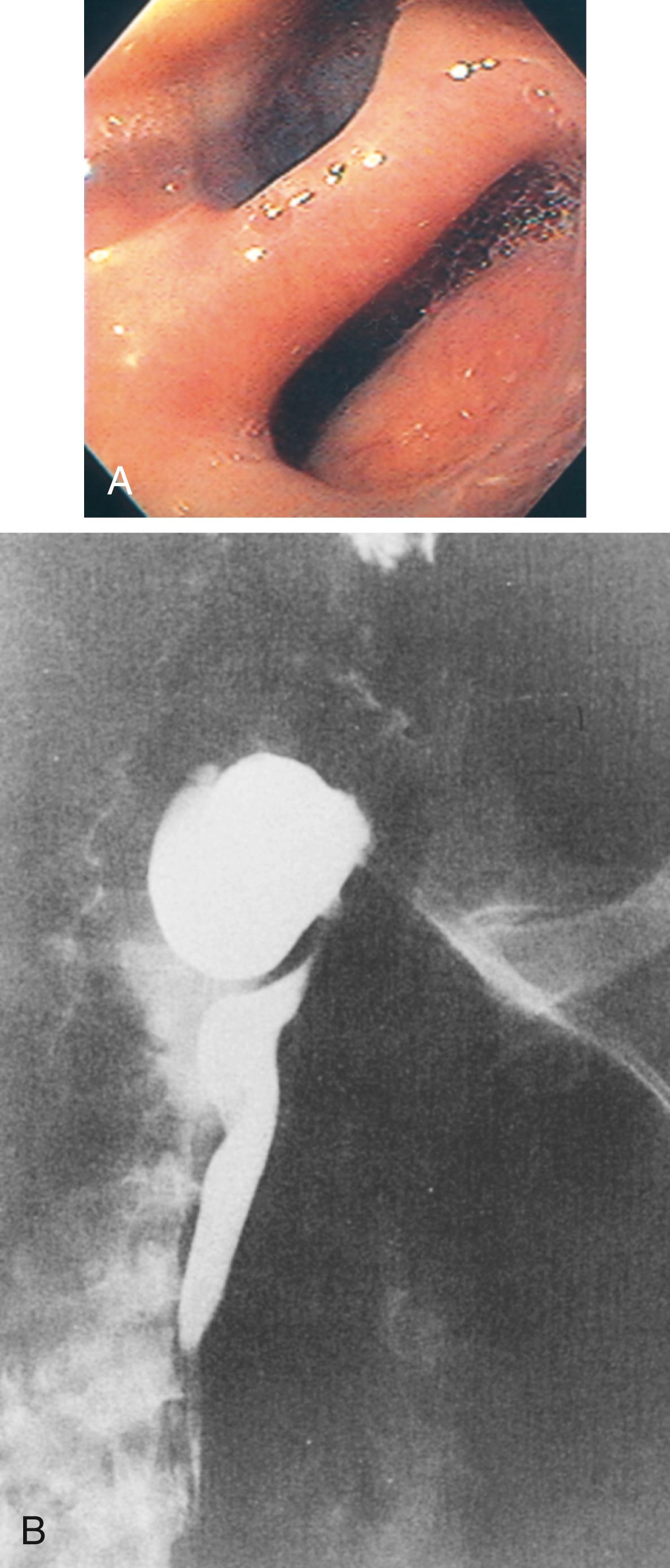
Zenker diverticula may be discovered incidentally during barium swallow or upper endoscopy (see Fig. 26.1A ) carried out for investigation of unrelated problems. When evaluating patients with symptoms suspicious for the presence of a Zenker diverticulum, consider obtaining a barium swallow prior to endoscopic evaluation. During endoscopy, Zenker diverticulum should be suspected if, on entering the pharynx, the UES cannot be located. In such cases, the endoscopy should be stopped, and the patient sent for a barium study.
Squamous cell cancer may develop in Zenker diverticula; the estimated incidence is 0.4% to 1.5%. If myotomy without diverticulectomy is planned, it is prudent to carefully inspect the lining of the diverticulum for any evidence of cancer.
Bleeding may occur from ulcerated Zenker diverticula. Aspiration of retained food contents may lead to aspiration pneumonia. Medications may become lodged in Zenker diverticula and can cause ulceration and pain, as well as decreased medication effectiveness. Because a Zenker diverticulum is occasionally palpable on physical exam, it can be difficult to distinguish from a large thyroid nodule, and accumulation of radioactive iodine tracer in a Zenker diverticulum has been reported to lead to erroneous diagnosis of metastatic thyroid cancer. The videocapsules used for capsule endoscopy may also become lodged in Zenker diverticula and should be delivered into the stomach with an endoscope when such studies are required.
Intubation of the trachea or the esophagus may be complicated by the presence of a Zenker diverticulum. A large diverticulum displaces the lumen of the esophagus. The tip of the intubation instrument is often directed preferentially into the diverticulum. At endoscopy, it may be difficult to distinguish the lumen of the diverticulum from the true lumen of the esophagus (see Fig. 26.1A ). Endotracheal intubation, placement of a nasogastric tube, and intubation of the esophagus for upper endoscopy, endoscopic retrograde cholangiopancreatography, or transesophageal echocardiography may be difficult. Perforation can occur. Intubation of the esophagus in patients with Zenker diverticula should be performed under direct vision. When a large Zenker diverticulum causes marked anatomic distortion or when intubation with a side-viewing endoscope is required, direct intubation is not prudent. In such cases, a forward-viewing endoscope can be used to pass a soft-tipped guidewire into the esophageal lumen. The guidewire is then back-loaded into the endoscope, and the endoscope is advanced into the esophagus over the guidewire. An alternative technique consists of passing a forward-viewing endoscope loaded with an overtube. Once the endoscope has been passed into the esophagus, the overtube is advanced, the forward-viewing endoscope is withdrawn, and the side-viewing or ultrasound endoscope is passed through the overtube.
Patients with small asymptomatic or minimally symptomatic diverticula can be followed, because progressive enlargement is uncommon. Patients with large and symptomatic Zenker diverticula should be offered treatment.
Zenker diverticula may be treated by open surgical procedures or by transoral endoscopic techniques using rigid or flexible endoscopes. Open surgery for Zenker diverticula is typically performed through the left neck in patients with large (>5 cm) diverticula that extend into the thorax. Young patients and patients with small diverticula may also be candidates for open surgery. Large diverticula can be resected, inverted, or suspended (diverticulopexy). Cricopharyngeal myotomy is performed to treat the hypertonic cricopharyngeus muscle, and is the key aspect to treating this disorder; the hypertonic cricopharyngeus muscle must be divided to relieve distal obstruction. If diverticula are resected without myotomy, there is an increased risk of postoperative leaks and an increased frequency of recurrence. Complications of open surgery include anastomotic leaks, mediastinitis, esophagocutaneous fistula, and vocal cord paralysis from injury to the recurrent laryngeal nerve, which runs in the tracheoesophageal groove. One review of 22 research studies including 1793 patients who underwent open surgery for Zenker diverticulum found an initial success rate of 96%, a morbidity rate of 11%, a 5% perforation or leak rate, and a 3.5% symptom recurrence rate over a median of 36 months of follow-up.
Endoscopic treatment of Zenker diverticulum can be performed using a rigid endoscope or flexible endoscope, with division of the fibrotic septum between the esophagus and the diverticulum. Compared with open surgical approaches, endoscopic approaches are associated with shorter anesthesia times, lower complication rates, and shorter hospital stays. Endoscopic techniques are suitable for patients with medium-sized diverticula (2 to 5 cm). Rigid diverticuloscopes and flexible endoscopes have been used. The diverticuloscope provides visualization of the lumen of the esophagus and diverticulum and the septum between them ( Fig. 26.2 ). This septum is composed of the posterior wall of the esophagus and the anterior wall of the diverticulum and includes the UES. The muscular layers of this septum (and UES) are incised, restorating a single lumen.
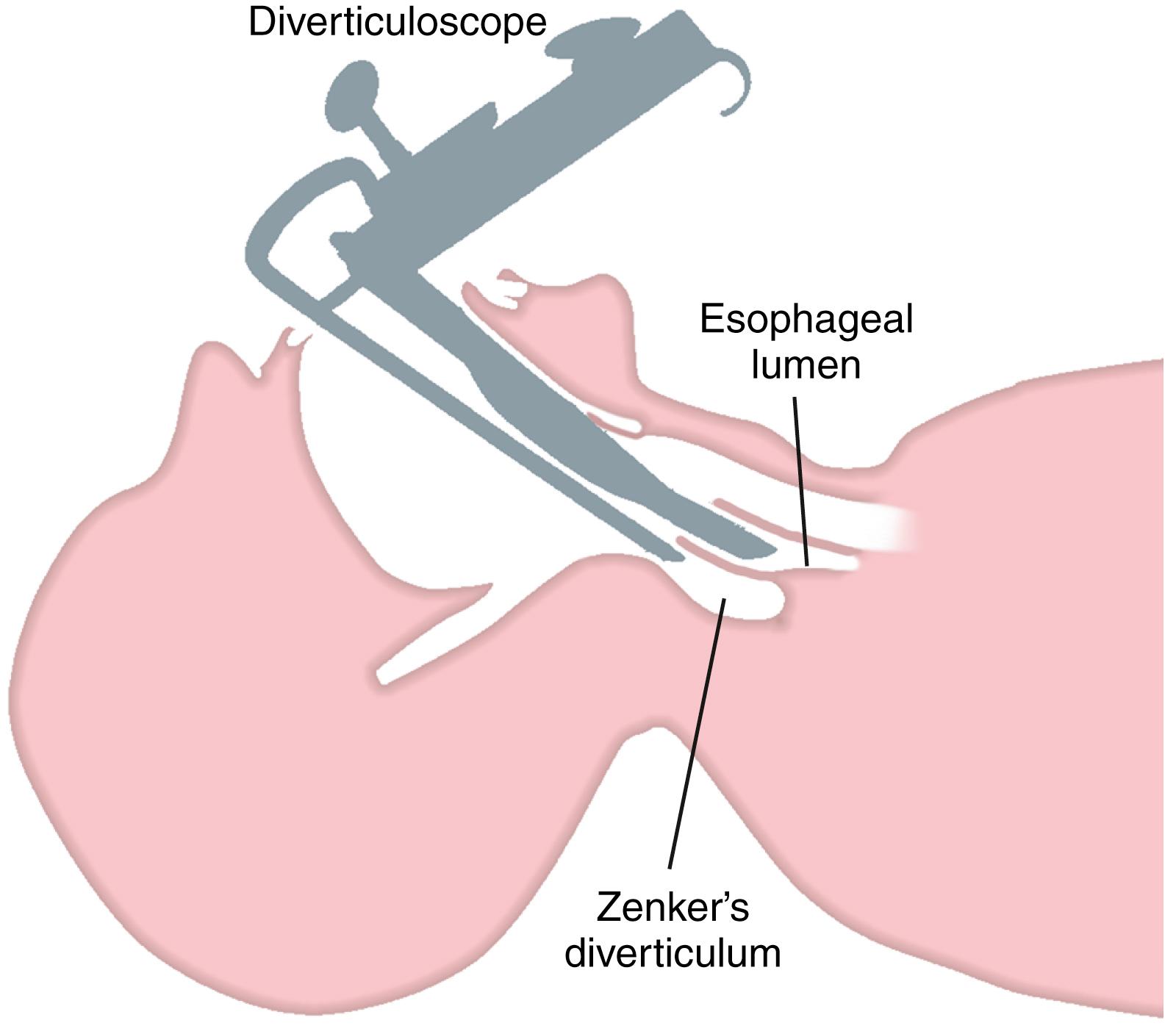
The incision can be performed by a number of techniques. With a rigid diverticuloscope, CO 2 laser, surgical stapling, argon plasma coagulation, electrocautery, or harmonic scalpel can be used for the procedure. During endoscopic stapling, one leg of the stapler is placed in the esophagus and the other into the diverticulum. The septum is then divided and stapled with 2 rows of staples on each side of the division line. The Zenker diverticulum must be at least 3 cm in length to be able to seat an adequate length of the stapler. Modifications of the stapler and other techniques may improve results in short diverticula. Complications of endoscopic procedures include bleeding, perforation, and leaks, but these are uncommon if a stapler-assisted technique is used. In a review of rigid endoscopic treatment of Zenker diverticulum, combining 11 studies of 494 patients, the median initial success rate was 95%, with a 4% rate of conversion to open surgery, a 3% rate of major morbidity, with recurrence of symptoms in 5% over a median follow-up of 16 months. Flexible endoscopic techniques also have a role in the treatment of Zenker diverticula because rigid diverticuloscopes cannot be used in patients who have limited neck extension or limited ability to open their mouth. Transparent caps or a soft diverticuloscope may be attached to the endoscope to improve visualization. A variety of techniques can be used to perform the endoscopic myotomy, including needle knife, argon plasma coagulation, monopolar forceps, or harmonic scalpel. Complications of flexible endoscopic techniques include cervical and mediastinal air dissection, which are common, as well as perforation and mediastinitis. In a review of 20 studies of flexible endoscopic treatment of 813 patients with Zenker diverticula, the initial success rate was 91%, with an 11% adverse event rate, and an 11% recurrence rate after a median of 23 months of follow-up. Flexible endoscopic treatment of Zenker diverticula has typically been performed by surgeons, but some expert endoscopists have begun performing these procedures ( ).
Video 26.1 Endoscopic treatment of Zenker diverticulum.
Diverticula of the esophageal body are most commonly located in the middle or lower third of the esophagus ( Fig. 26.3 ).
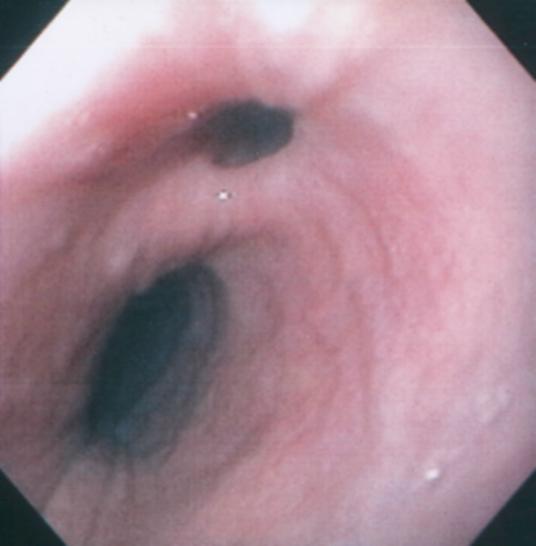
Estimates of the frequency of esophageal body diverticula vary from a prevalence of 0.015% seen on autopsy to 2% in patients referred for radiologic evaluation of swallowing disorders. These diverticula can be divided into 2 types: traction and pulsion diverticula . Traction diverticula are related to an inflammatory, fibrotic, or neoplastic process outside of the esophagus. Traction diverticula are often related to mediastinal inflammation associated with tuberculosis or histoplasmosis. Enlarged mediastinal lymph nodes from lung malignancies can also lead to traction diverticula. Pulsion diverticula are typically caused by motility disorders.
The most common type of pulsion diverticula is an epiphrenic diverticula , which is located near the diaphragmatic hiatus ( Fig. 26.4 ). About 80% of epiphrenic diverticula are associated with esophageal motility disorders such as achalasia or distal esophageal spasm, which are discussed in Chapter 43 . Epiphrenic diverticula have been reported as a complication of band-based obesity surgery, due to obstruction of the esophagus and upper stomach by the band (see Chapter 8 ). Congenital bronchopulmonary-foregut malformations can also present with esophageal diverticula.
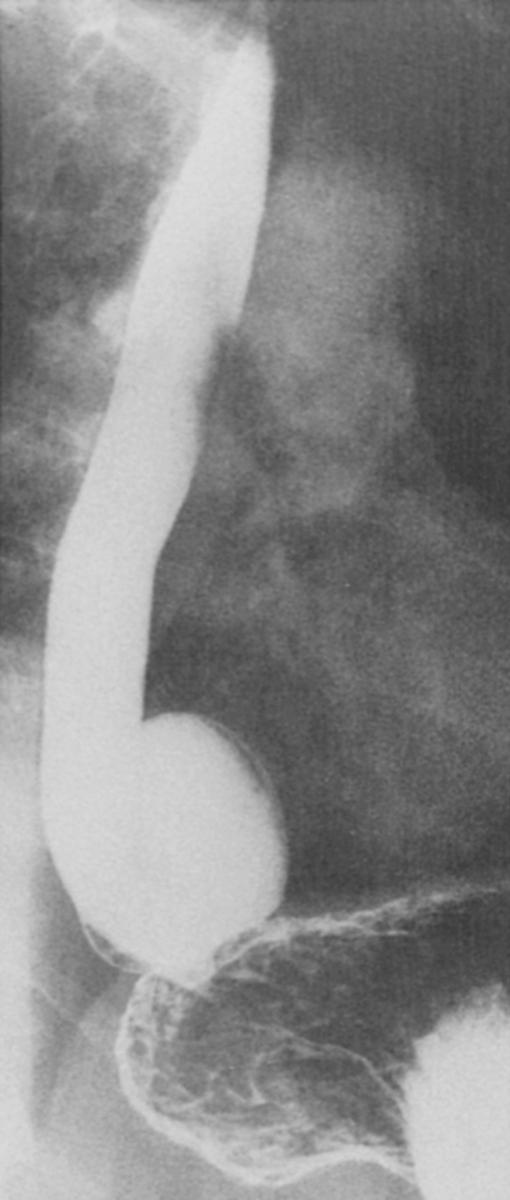
Congenital and traction diverticula of the esophagus are usually asymptomatic, particularly when in the mid and lower esophagus. If symptoms are not present at diagnosis, they rarely occur during follow-up. When symptoms occur, the most common are dysphagia, food regurgitation, reflux, weight loss, and chest discomfort. Dysphagia may be caused by an underlying motility disorder or by extrinsic compression of the esophagus by a large diverticulum, with preferential filling of the diverticulum. Bronchopulmonary-foregut fistulas can develop, however, leading to cough, pneumonia, and recurrent bronchopulmonary infections. Diagnosis of epiphrenic diverticulum can be made during endoscopy or barium radiography. An epiphrenic diverticulum may be mistaken for a diaphragmatic hernia or duplication cyst on chest radiography. Endoscopy may show an empty diverticulum or the presence of food debris ( Fig. 26.5A ). Diagnosis is best made by barium swallow, which serves to visualize the diverticulum and localizes it more precisely than endoscopy (see Fig. 26.5B ). The radiologist must be alerted to the possibility of this diagnosis, because oblique views will be required to demonstrate the diverticulum. CT should also be considered to ensure no associated pathologic adenopathy or mass lesions that might be causative of a pulsion diverticulum.
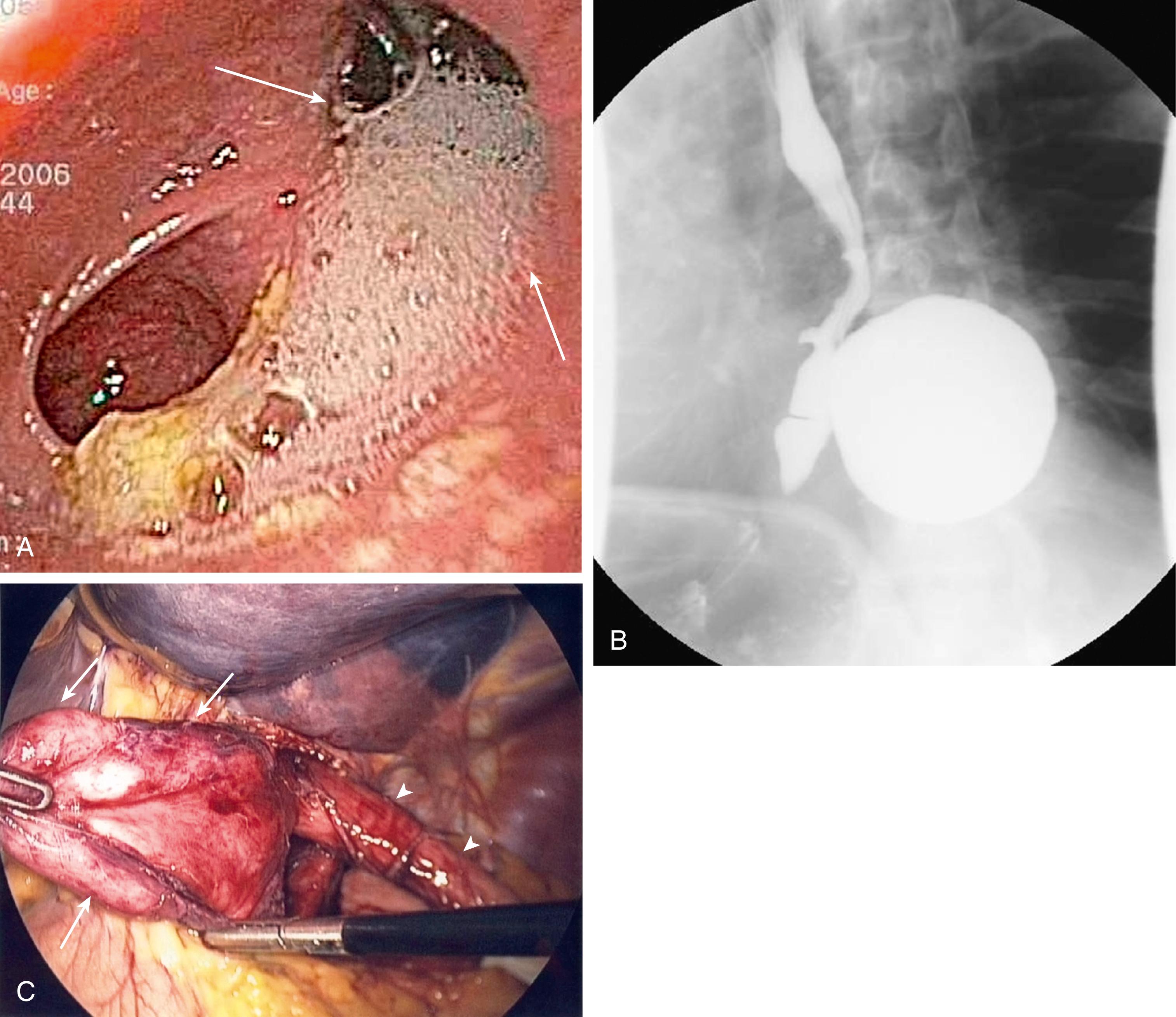
Squamous cell carcinoma has been reported in epiphrenic diverticula. As with Zenker diverticula, accumulation of radioactive iodine tracer in esophageal diverticula has been mistaken for metastatic thyroid cancer. Bleeding from an ulcerated esophageal diverticulum has been reported. Regurgitation and aspiration of the contents of the diverticulum may complicate induction of anesthesia. Perforation is possible during nasogastric intubation or UGI endoscopy
Asymptomatic diverticula of the esophagus need no treatment. Only patients with symptoms clearly related to their diverticula should be treated. Preoperative endoscopy and manometry are advisable. It can be difficult to pass a manometry catheter beyond the diverticulum and into the stomach, but documentation of achalasia or distal esophageal spasm is helpful for guiding treatment. Surgical treatment of esophageal diverticula can be performed by open, laparoscopic, combined laparoscopic-thoracoscopic, or robotic techniques. Epiphrenic diverticula are often amenable to a laparoscopic approach, which has the advantages of a shorter hospital stay and a quicker return to normal activities (see Fig. 26.5C ). Large diverticula may be inverted or resected. Given the high prevalence of associated motility disorders such as achalasia, esophageal myotomy is performed in most cases. Small diverticula can be treated by myotomy without resection. The advantage to forgoing the diverticulectomy is that there is no staple line to heal, decreasing the risk of a leak. It must be understood that the symptoms are usually related to the underlying motility disorder and not the diverticulum itself. Therefore, treating the underlying condition, usually with myotomy, is the key component of the surgery. To prevent gastroesophageal reflux after myotomy, a partial posterior (Toupet) or anterior (Dor) fundoplication may be performed.
The prognosis for patients who undergo surgery for esophageal diverticula is good, with rates of symptom improvement of 88.5%, with better symptom response rates when diverticulectomy is performed.
Esophageal intramural pseudodiverticula (EIP) were first described in 1960. The pseudodiverticula are flask-shaped outpouchings from the lumen of the esophagus, ranging in size from 1 to 4 mm.
EIP are more common than the small number of published case reports would imply. EIP have been demonstrated in 0.09% to 0.15% of barium swallow studies. Patients are found to have EIP most commonly in their sixth or seventh decades. The condition is slightly more common in men than in women.
EIP are abnormally dilated ducts of submucosal glands. They are thought to be acquired and are often associated with conditions that cause chronic esophageal inflammation. The ducts may become dilated because of periductal inflammation or fibrosis. Esophageal strictures are commonly associated with EIP, but GERD, chronic candidiasis, caustic ingestion, esophageal cancer, and eosinophilic esophagitis are also associated with EIP. Marked thickening of the esophageal wall has been noted in some cases by CT or EUS.
Become a Clinical Tree membership for Full access and enjoy Unlimited articles
If you are a member. Log in here